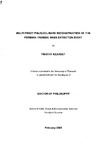Multi-proxy palaeoclimate reconstruction of the permian-triassic mass extinction event
| dc.contributor.author | Kearsey, Timothy | |
| dc.contributor.other | School of Geography, Earth and Environmental Sciences | en_US |
| dc.date.accessioned | 2011-09-22T15:04:25Z | |
| dc.date.accessioned | 2013-10-08T11:53:14Z | |
| dc.date.available | 2011-09-22T15:04:25Z | |
| dc.date.available | 2013-10-08T11:53:14Z | |
| dc.date.issued | 2009 | |
| dc.date.issued | 2009 | |
| dc.identifier | Not available | en_US |
| dc.identifier.uri | http://hdl.handle.net/10026.1/615 | |
| dc.description | Access to the full-text thesis is no longer available at the author's request, due to 3rd party copyright restrictions. Access removed on 28.11.2016 by CS (TIS). | |
| dc.description | Metadata merged with duplicate record (http://hdl.handle.net/10026.1/2096) on 20.12.2016 by CS (TIS). | |
| dc.description.abstract |
The Permian/Triassic (P/Tr) boundary is widely assumed to have been a time of extreme environmental upheaval and change. In the terrestrial realm, a negative anomaly in 813C isotope values has been reported from organic carbon in Antarctica, Australia, India and Madagascar, and from marine carbonate in the Karoo Basin. However, these sections are all from southern palaeolatitudes. Analysis from the Permian-Triassic terrestrial sedimentary record of the South Urals, in Russia, comprising of many Aridisol and Vertisol horizons has revealed that, like the Southern Hemisphere, there is a dramatic change in paleosol morphology across the P/Tr boundary linked to a shift from meandering rivers to conglomeratic alluvial fans. Most of the paleosols include pedogenic carbonates at different stages of development, both above and below the P/Tr boundary. By the Triassic there is evidence of depressed water tables and increased seasonality. Analyses of the S13Qarba nd S18Ocarbsi gnatures of these pedogenic carbonates have revealed a number of negative excursions in 813Ccarabn d 5180carbin the Late Permian, including a negative excursion in the mid-Changhsingian, the first time such an event has been recorded in a terrestrial environment. Associated with this excursion are indicators of increasing extremes of climate, including pedogenic dolomite, which suggest a dramatic change in climate up to the P/Tr boundary. Equally, there is an increase in the range of precipitation, suggesting that what caused this mid-Changhsingian event also had a profound effect on the atmosphere. There is also evidence, in the form of the 818Ocaeßx, cursion, of a rise in temperaturej ust prior to the onset of the conglomeratic alluvial fan deposits, which mark the P/Tr boundary in Russia. Although in the Russian paleosols this excursion could be explained by a rise in the effect of seasonal rain or atmospheric temperature, estimates from unaltered brachiopods from the Italian Dolomites confirm that there is a rise in temperature and suggests that this is in the region of 7-8°C. These paleosols also record a dramatic rise in pCO2 in the Earliest Triassic similar to what has been recorded in stomatal records across this period suggesting a dramatic input of CO2 in to the atmosphere. | en_US |
| dc.language.iso | en | en_US |
| dc.publisher | University of Plymouth | en_US |
| dc.title | Multi-proxy palaeoclimate reconstruction of the permian-triassic mass extinction event | en_US |
| dc.type | Thesis | |
| plymouth.version | Full version | |
| dc.identifier.doi | http://dx.doi.org/10.24382/4088 |
Files in this item
This item appears in the following Collection(s)
-
01 Research Theses Main Collection
Research Theses Main



